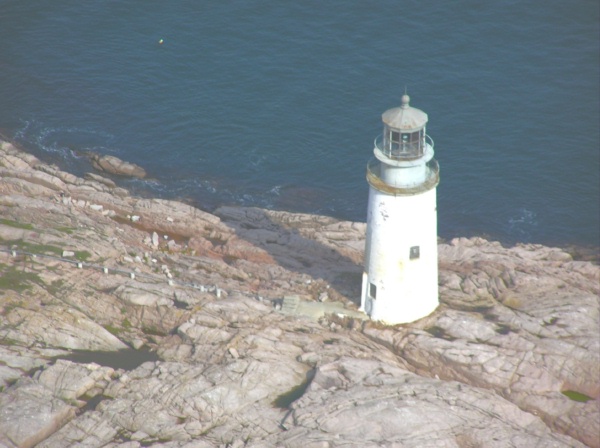Stan and I traveled to New Hampshire and Maine on a lighthousing trip. We saw the three lights on Lake Sunapee in New Hampshire on Sunday, 9/23/07. The New Hampshire lights were Stan's practice run with his new camera. We saw forty in the State of Maine in the week that followed. Thanks, Sandy
BURKEHAVEN LIGHT, NH. White hexagonal lighthouse is located on a rock at the tip of Burkehaven Island and is the southernmost of three lighthouses built in the 1890s by the Woodsum Brothers. The brothers owned the steamships that brought vacationers from New York, New Jersey, and Connecticut by train to summer at Lake Sunapee, a shimmering peaceful lake with tree-lined shores and quiet coves. Mount Sunapee, rising some 2,700' at the southern end of the lake is home to a downhill skiing resort. When steamship service on the lake ended following the Great Depression, the lighthouse was left to deteriorate. Crushing ice destroyed the light in 1936.
Renewed interest in this and the other two lights in the 1980s resulted in the raising of funds to rebuild the lighthouse and the crib on which it was built. Solar panel lights were installed in the mid-1980s. Ice strangled the lighthouse again in 1994, severely damaging the crib which was rebuilt for the second time.
Owned by the State of New Hampshire and maintained by the Lake Sunapee Protective Association.
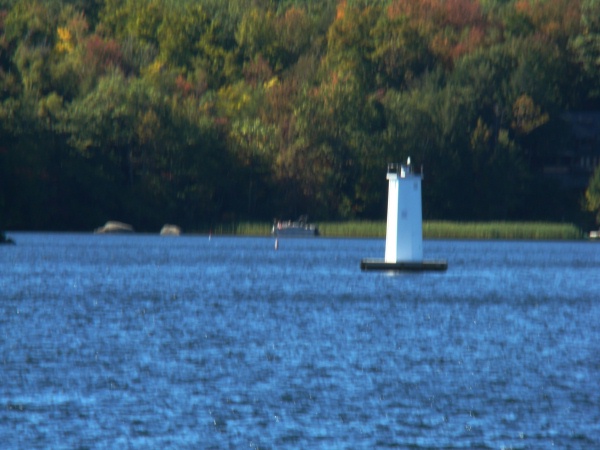
HERRICK COVE LIGHT, NH. This white, wooden, hexagonal lighthouse stands at the entrance to Herrick Cove. Prior to its 2004 restoration, it had black trimmed panes. Built in 1893 by the Woodsum Brothers, owners of the lake’s steamships. When the Great Depression occurred and the grand era ended, the lighthouse was left to deteriorate. In 1965, it was refurbished. Repairs necessitated by ice damage were accomplished in 1983, and a solar powered light was installed.
The only light of the three on Lake Sunapee that has not been fully replaced, Herrick Cove was airlifted off its base by a helicopter in 2003 so that repairs could be made to the rotting wooden crib and the tower. The weight had been estimated to be around 3,300 pounds. However, the weight was considerably more than the estimate and the lighthouse took an unexpected swim. The helicopter had a lifting capacity of 5,000 pounds and quickly raised the lighthouse out of the water and delivered it to the lawn of the chair of the Lake Sunapee Protective Association’s (LSPA) committee.
The chair’s daughter, Ginger Cross Shaw, died in an avalanche in 1996 while heli-skiing in Wyoming. In her memory, many contributions were made to the LSPA. The Cross family decided to apply the donations toward the cost of restoring the tower. A new crib was constructed, the rotted components of the tower’s framework were replaced. In July of 2004, the framework and a 700 pound to piece were lifted by helicopter to the restored crib and the lighthouse was covered with modern maintenance-free panels.
The Herrick Cove Lighthouse, now also known as Ginger’s Light, is owned by the
State of New Hampshire and is maintained by the Lake Sunapee Protective Association.
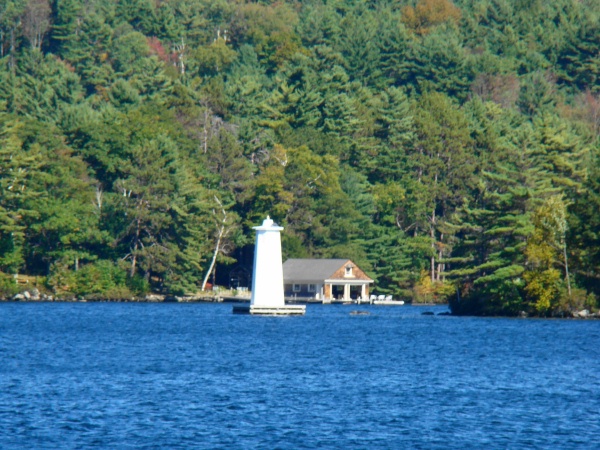
09/23/2007. LOON ISLAND LIGHT, NH. Lake Sunapee is a long, narrow lake stretching
ten miles from north to south. Its name is Algonquin and means “wild goose lake.” In the late 19th century, the lake became a popular destination for travelers from New York, New Jersey, and Connecticut. They arrived by train to Sunapee Harbor and boarded steamships for the resort hotels and family estates along the shoreline.
The steamer “Edmund Burke” struck an underwater ledge at Loon Island in 1891. The accident led to the construction of a lighthouse on the small island located near the middle of the lake. The wooden tower was built in 1893 by the Woodsum Brothers, owners of the steamships. In 1896 the lighthouse caught on fire when the fire department was working on repairs. The firemen extinguished the fire with lake water and finished the repairs.
The second tower was struck by lightning in 1960 and burned down; it was rebuilt that same year following a fund drive for private contributions. In the 1980s solar panels were installed in the lighthouse.
The Great Depression took its toll on Lake Sunapee and saw the decline of steamboats and grand hotels. The lighthouse still guides the marine craft that use the lake for recreation.
The lighthouse is owned by the State of New Hampshire and is maintained by the Lake Sunapee Protective Association.
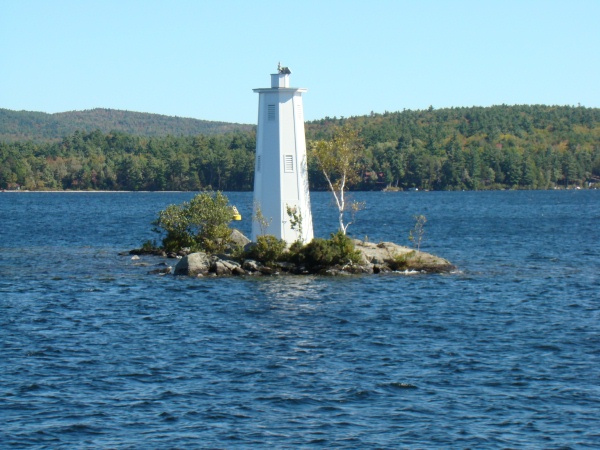
We traveled to Bar Harbor, ME on Monday, 9/24/07, picked up the rental car, and set up the RV at a campground. On Tuesday, the 25th we arrived at Scenic Flights of Acadia for the first of two flights that day. I’d contacted Vicki a week or so before we left CT and gave her a list of all the lights we hoped to see; she, in turn, worked out a flight plan with her pilot. We planned to fly to the 25 lights I’d listed over two days–weather forecasts changed that to a single flight on what was a beautiful day:
We started the first leg of the flight with:
NASH ISLAND LIGHT, ME. Built in 1873 and inactive since 1982, this square pyramidal brick tower with lantern and gallery is attached to a small brick workroom. The buildings were painted white, the lantern and gallery black. Keeper’s house and all other light station buildings were demolished following automation of the light in 1958; the foundation ruins remain. The tower is a sibling of Burnt Coat Harbor Light. A local support group was granted ownership under the Maine program in 1997 and began repairing the lighthouse. The brickwork and windows have been restored, the tower has been painted, and restoration work has begun in the interior. The island is part of Maine Coastal Island National Wildlife Refuge and is an important seabird nesting site that is closed to the public April through August.
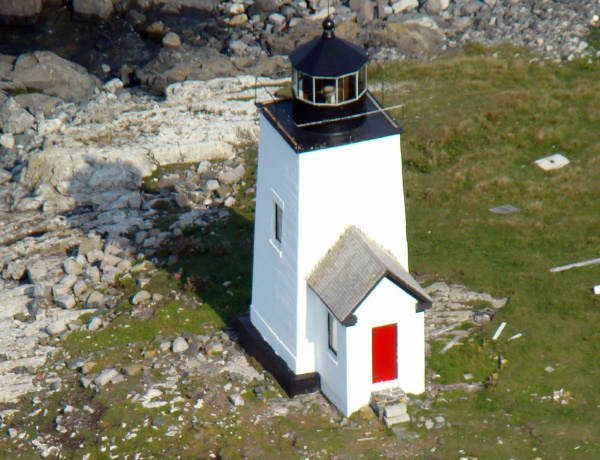
MOOSE PEAK (MISTAKE ISLAND) LIGHT, ME. Built in 1851, this active 57' round brick tower with lantern and gallery has a solar-powered DCB-24 aerobeacon and a focal plane 72' above sea level shows a white flash every 30 seconds. Located on Mistake Island, a small island about 5 miles southeast of Jonesport. The tower is painted white, the lantern and watch room black. Its fog horn sounds 2 blasts every 30 seconds. The keeper’s house was demolished in 1982 in a military demolition exercise; the lighthouse was slightly damaged in the explosion. Its brick fog signal building was built in 1912. Resembling Sankaty Head, MA light, it is one of the first “early classic” style masonry towers. The height of the tower was increased in 1886 by adding a watch room below the lantern. Its 1856 2nd-Order Fresnel lens has been restored by volunteers from the Chesapeake Chapter of the US Lighthouse Society. It was to be displayed at the Maine Maritime Museum in Bath, but the hardware needed to assemble the lens has not been located. The lighthouse was refurbished and converted to solar power in 1999. Mistake Island is a nature preserve and visitors must use the boardwalk to access the lighthouse. Owned by the US Coast Guard, its site manager is the Maine Nature Conservancy; it is part of the Great Wass Island Preserve.
